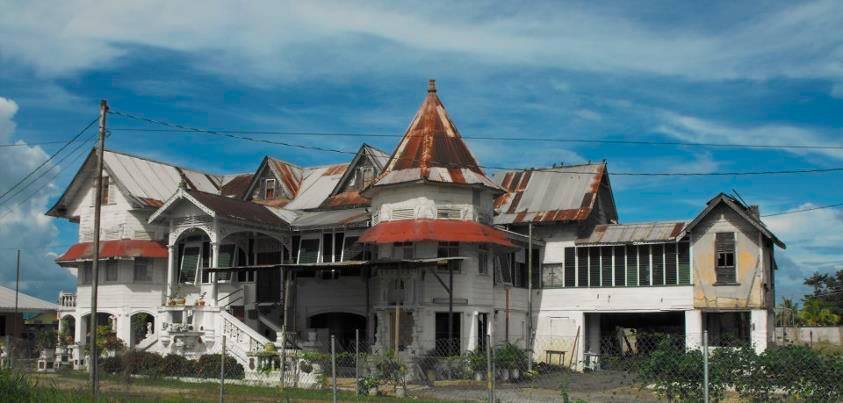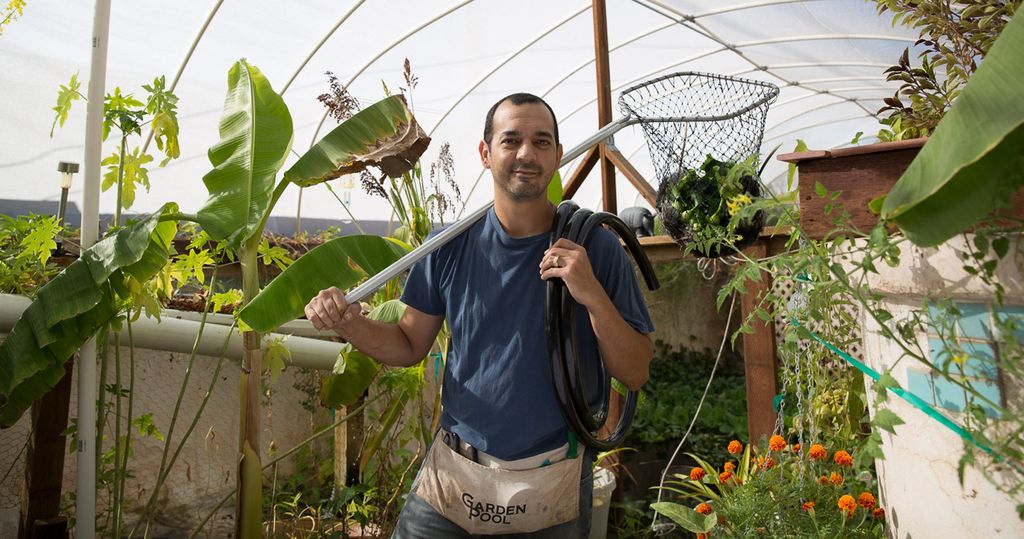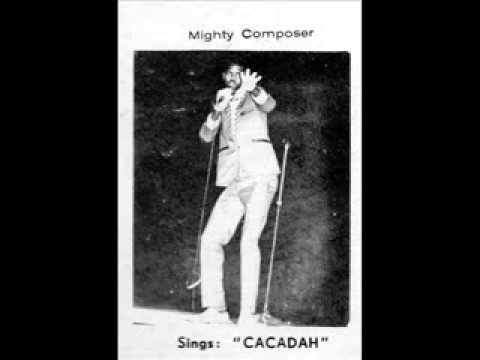|
Nine years ago, Dennis McClung had a rundown swimming pool and an ambitious goal, to plant a garden that would provide a self-sustaining food system for his family.
McClung and his wife transformed the empty cement pit behind their home in Mesa, Arizona, into a closed-loop ecosystem teeming with life, from vegetables to chickens, even a pond with tilapia. The innovative urban farm was soon producing enough food to feed the couple and their three young children, cutting their monthly grocery bill by almost half. But what McClung accomplished after that is even more remarkable. With no formal training, just plenty of ingenuity, hard work, and resourcefulness, McClung is now helping people around the world build climate-resilient and highly productive food systems. Since launching his nonprofit organisation Garden Pool, in 2012, McClung’s backyard experiment has bloomed into a multifaceted operation that is collaborating with foreign governments on food sustainability, operating public seed libraries, offering classes and workshops, developing a solar-powered water sterilisation system and most recently, working on a HoloLens application designed to help users build customised food systems. Though McClung’s farming methods might be low-tech, the technology he uses to power his organisation is not and driven by Microsoft. He uses Windows 10, Office 365 and a Surface device for graphic design, research, proposals, and marketing; collaborates with employees and volunteers remotely via Microsoft Teams; and uses Skype to teach a 3D modelling course to interns. Working with Chaney St Martin who is based in T&T, the Golden Grove Prison became the site of his latest imitative where inmates had been tending an enclosed garden in a field by hauling watering cans back and forth in the blazing heat. McClung set up a self-irrigating water collection system and a fish pond and added vertical growing, raising plants in stacked layers instead of in the ground to boost the garden’s production. Prison administrators were so excited about the changes that they asked for their own training session. “They said the project served as a model for them to do the same thing on their own farms,” says Chaney St Martin, an international specialist in water and soil management for the Inter-American Institute for Cooperation on Agriculture (IICA), which partnered with Garden Pool on the Trinidad project and several others in the Caribbean. There was almost no budget for the Trinidad prison project, McClung said, so instead of using a premade liner for the fish pond, he made one by mixing cement and sand. He built the pond’s pump from spare pipes and used some old cement blocks to create raised garden beds. “We really had to be MacGyver on this one, because the prison really didn’t have any budget,” McClung says, laughing. “We just looked at what they had, and we got really creative.” St Martin, met McClung at a conference a few years ago. The two got talking and resolved to work together in the Caribbean. When Hurricane Irma raged through the region in September 2017, devastating several islands, they seized the opportunity to help. McClung, unencumbered by the bureaucracy of a large organisation, and his data quickly mobilised resources and arrived on the ground to work with the IICA, St Martin said. “It was a tremendous effort. If you understand the Caribbean context, people tend to be suspicious when outside organisations come in,” he says. “But Dennis was able to come in and blend in very easily with the culture. People really loved the work that he did.” McClung is turning to data collection to validate and quantify his models for sustainable farming. He’s working with governments in countries where Garden Pool has conducted projects to collect data on farm yields, productivity, and costs, and is partnering with Joel Cuello, a professor of agricultural and biosystems engineering at the University of Arizona and an expert on vertical farming, on the HoloLens project. With his first international office based in Trinidad, using datasets from their work, McClung and Cuello plan to develop a HoloLens app using Microsoft AI and other services that will allow users to select a food system model and scale it to a particular space. The app will tell them how much the project would cost, what materials are needed and how much it would produce. The goal is to have a prototype by the end of next year, Cuello said. He sees information sharing as critical to Garden Pool’s ultimate goal of promoting global food security. “No one on this planet should be hungry with the technology available to us right now,” he says. “It’s just a matter of using it efficiently and spreading it to those who need it. “The fact that we’re changing the world is more important to me than being rich or taking the fame and the glory for it,” McClung says. “I’d rather share the knowledge so that others can do for themselves.” Source: Trinidad Guardian, Dec 2018
0 Comments
 A few weeks ago, the country lost one of its most valuable architectural treasures. For generations, the magnificent Friendship Hall Great House stood astride the Southern Main Road, just north of St Mary's Junction in Freeport and reminded us of an era long gone. Not only was the structure imposing in its sheer size, but also for its eccentric style and the story it bore. Constructed in the 19th century, it was initially a prime example of colonial plantocracy architecture which far outshone the less substantial planters' residences which dotted the sugar cane fields of central Trinidad. Its owner was an eccentric Scotsman named Norman McLeod who had served as an officer in the British East Indian Regiment in the early 1900s. Whilst in India he apparently underwent a conversion to Hinduism and upon his return to Trinidad he employed his considerable artistic ability in transforming his palatial home into a mandir. On the ground floor, the goddess Durga peered forth, while on the sweeping portico, McLeod placed a self-portrait, wearing a turban. He even constructed a throne with the words "Friendship Hall" above it. The Scotsman filled his home with priceless treasures ranging from a World War I German bugle to invaluable silver from India. Gripped with a growing delusion that the young daughter of one of his Indian servants was a reincarnation of his dead mother, McLeod willed his mansion to them when he died in 1965. We live however, in a nation where all but a few place no value on the legacy of the ages. Friendship Hall fell into neglect and after nearly five decades of decay, was bulldozed into the ground to make way for concrete blasphemies which are a sad travesty of the Scotsman's gift to his heirs. As appalling as this assault on our built heritage is to conceive, it is but a single chapter in a long history of annihilation which cannot be blamed on any one person or sector, since it is a reprehensible burden we must all bear as a people. The basic argument which may be proffered for the fate of Friendship Hall is that without legitimate state support, this is to be the future of many of our historic structures which exist in private hands which are either unappreciative of their significance or cannot afford to sustain them. Part of the problem stems from a scarcity of compassion and public edification regarding the value of heritage assets. There are now two ministries dedicated to multiculturalism and tolerance, yet nothing has been done to inculcate a sense of national pride in our past. Students are still taught that Columbus sighted Trinidad from the helm of the Santa Maria accompanied by the Nina and Pinta, even though he was barely able to walk from a smart attack of gout and all three ships had been sunk years before. I dare say if the owner of Friendship Hall Great House had possessed a cultured appreciation for what was gifted into his care, it would not have been destroyed. The wholesale slaughter of leatherback turtles but a couple decades ago has been all but halted, thanks largely to the foundation of a sense of ownership which was instilled in the minds and hearts of those who shared a common breathing space with the turtles. Most communities in possession of heritage assets cannot see the economic opportunities which can arise from these treasures. This is another page we can take from the book of the leatherback turtle story, since turtle-watching is now a lucrative money-earner for several sectors, spawning downstream industry on a micro-economic scale. Lest it be said that I lambast the State too sternly, an example must be drawn from the awful condition of the Magnificent Seven. These turn-of-the-century masterpieces appear in virtually every tourist guidebook which beckons the unsuspecting to view a spectacle which must surely stand as an indictment against us. From the boarded-up windows and unkempt lawns of Mille Fleurs to the threadbare grandeur of Whitehall, successive administrations have gleefully ignored their responsibility to history. Those few public institutions dedicated to conservation have consistently failed in their mandates and seem quite happy to continue on their losing streaks while our past is trampled and lost. I recently visited the National Museum and it pains me exceedingly to see the vast potential for public education therein and the deficiency of interest which is shown in it. The proverbial icing on the cake in the visit was that in one section, artefacts were strewn willy-nilly with no security, begging the souvenir hunter to pocket one of our national treasures. There is a Restoration Unit within the Ministry of Works and Infrastructure. Had I not been aware of its presence, I would be as stunned as most people would be to learn that such a high-minded department could exist within the wreckage of our civil service. One only has to look at our communal architectural treasures to see the impact of the unit on the landscape: the still-caved roof of President's House, the fire-gutted shell of what used to be the historically significant San Fernando Police Station and the sapling which threatened to grow into a mighty tree from the roof of the now dismally abandoned Red House. The lack of zeal or even periodic enthusiasm from the public sector towards preservation is really an extrapolation of a national mentality which frowns on the past. Our own first prime minister, Dr Eric Williams, was, most ironically, a historian. Even more than three decades after his death, the effects of "doctor politics" still shape the general psyche of the nation, wherein he transferred his inner demons of his own exclusion from colonial elite society to his people, teaching us that all that was connected to massa was bad and should be obliterated if we were to find ourselves. In this way, we indemnify the Plantation Society model of the late, great Lloyd Best, since our idea of nationalism finds expression in raging against the European metropole and its relics by extension. We are a plural society thrown into each other's company with no real formation of the characteristics of a nation. Yet, amid the morass of destruction and callous ignorance, there are beacons of hope. For many years, a small band of dedicated people calling themselves Citizens for Conservation has been striving against enormous odds (political obstacles being the most frequent) to raise the national consciousness of our heritage and to persuade the relevant authorities of each administration to take a vested interest in preservation lest all be lost too soon. I doubt any of the members of Citizens for Conservation throw a good javelin or sing melodious rum-drinking ditties, but this is an organisation which truly deserves a medal for the tireless commitment to history of its members. Citizens for Conservation stalwart architect Geoffrey MacLean has devoted a lifetime to conservation and singlehandedly rediscovered our great 19th-century artist Michel Jean Cazabon and his works. Only recently Geoffrey and I were bewailing the fact that during the 1970s and well into the 1990s, most of our architectural heritage had been destroyed in the name of progress. Called to mind were the demolition of Bagshot and Perseverance Houses in Maraval, the Ice House Hotel on Abercromby Street, Port-of-Spain, and the old Customs House on the waterfront. The loss to posterity has truly been immense. Our most current dialogue on the demise of Friendship Hall Great House had a tone akin to that of lamenting the demise of an old friend. There is only so much that can be done by those of us who have spent our lives in ferreting out forgotten history and coping with the ever-expanding wasteland which our heritage landscape has become. Government malaise, ignorance of the general citizenry and corporate greed have combined to form a daunting front against conservation and as long as we see no value to cherishing the legacy of our ancestors, we face a very grim future, for it is from the glories and teachings of the past we must draw on to find inspiration for tomorrow. If this is indeed our lot, where then can future generations turn to find themselves? Source: Virtual Museum of T&T Archives (Sept. 08 2012)  A Trini Christmas is the best. And in large, contributing to this are our festive Christmas foods. We have perfected the grand art of fusion and created an original cuisine for this season. Some food gurus thumb their noses at the term fusion, however, we would not have this outstanding cuisine if our ancestral cooks had not utilised the art of fusion. Really, what they tried to do is recreate the familiar foods of their past, using ingredients available to them locally, and so through the years, we inherited what we know as our true Trini Christmas cuisine. These include boiling hams in pitch-oil tins, soaking black cake fruits for up to one year in advance to use in our black cakes; securing fig leaves to wrap pastelles, stocking up on enough rum for use in black cake and ponche de crème and baking bread to sandwich the ham and preparing garlic pork. Making pepper jelly and chow-chow to dress our meals, and preparing sorrel and ginger beer to cool us all down. Most of these traditions still live on today, thankfully, although some have sadly been substituted for more non-traditional foods at this time. For me, I am a lover of tradition and our Christmas cuisine. Making black cake is a big part of my Christmas tradition which I begin in October. I soak my fruits in a mixture of rum and cherry brandy for up to one month or more. I omit the browning, which I think imparts a bitter flavour to the cake, and I use a higher ratio of fruit which results in a dense, moist and very dark cake. It’s important to continue nursing the cake after baking for a few days with your choice of rum or brandy to keep it moist until use. Of course, you can opt for a non-alcohol version by replacing the alcohol with pure grape juice. And if you are not a lover of dark fruit cake, you can make a light fruit cake which is equally alluring on a different level! Light fruit cake 1 cup butter 1 cup granulated sugar 4 eggs 1/2 cup raisins 1/2 cup candied cherries, finely chopped 1/2 cup mixed peel 1/2 cup chopped walnuts or almonds, (optional) 2 cups all-purpose flour Preheat oven to 325 degrees. Finely chop fruits. Grease, line and flour 1 nine-inch round pan. With an electric mixer, cream butter and sugar until light and creamy, about 5 minutes. Add eggs one at a time beating well between additions. Fold in flour and fruits. Pour batter into a 9-inch round pan. Bake for about 11/2 hours. Cool. Best ever Christmas black cake 1 lb raisins 1 /2 lb currants 1/2 lb sultanas 1/2 lb prunes 1/2 lb chopped walnuts 1/4 lb mixed peel 1/4 lb cherries 1 2/3 cups dark rum 1 2/3 cups cherry brandy 1 lb Butter 1 lb all-purpose flour 3 tsp baking powder 1 lb brown sugar 6 eggs 1 tsp cinnamon and allspice, mixed 2 tsp mixed essence Combine rum and cherry brandy and add fruits to mixture. Let soak overnight or up to one week. Preheat oven to 300F. Cream butter and sugar until light and fluffy. Add eggs one at a time, beating well after each addition. Sift together flour and baking powder, cinnamon and allspice. Drain fruits reserve liquid. Chop or mince in food processor. Add drained fruits to butter and sugar mixture. Add cut up cherries and nuts. Fold flour into fruits and butter mixture. Add mixed essence, mix well. Grease and line two 9-inch cake pans with waxed paper, grease and flour paper. Spoon cake batter equally into prepared baking pans. Bake for 2 to 2 1/2 hours. Source: Newsday, Dec 2018 Bazodee is heading to India.
The Machel Montano love story featuring Bollywood star Kabir Bedi will be screened as part of the Chennai International Film Festival on December 14. In making the announcement on Instagram, the soca king said this is the first time films from Trinidad and Tobago will be screened at the Festival. "So I’m glad our movie will be included in this inaugural group. Many thanks to the High Commission of the Republic of Trinidad and Tobago in New Delhi, India for showcasing and promoting Bazodee," he wrote. The movie will be screed at the Devi Bala Theatre in Chennai. Bazodee premiered globally in 2016 and has since been screened in the US, Barbados, Jamaica, Montreal, Canada and London, UK. The movie won the Audience Award and Best Music Award at the Latin Asian Film Festival, which took place in London. Bazodee stars Montano, British Asian actress Natalie Perera, Trinidadian/British actor Valmike Rampersad and Indian/Russian star Staz Nair. Source: The Loop, Dec 2018. Port of Spain Mayor Joel Martinez and Tourism Trinidad Ltd Chairman, Janelle Penny Commissiong, at a meeting held by Port of Spain Rotary Club, Goodwill Industries, Fitzblackman Drive, Woodbrook. Behind is Tourism Trinidad Ltd Director, Joanna Gittens and Tourism Trinidad Ltd CEO Designate, Camille Campbell. PHOTO:ANGELO M. MARCELLE CHAIRMAN of the Trinidad Tourism Ltd and former Miss Universe 1977 Janelle “Penny” Commissiong said the number of visitors to Trinidad fell 3.6 per cent in 2017 from the previous year.
Making a comparison with the Bahamas, which has a population of about 400,000, Commissiong said 6.3 million people visited those islands in 2017, compared to 375,000 visiting TT, whose population is about 1.4 million. She said the Bahamas was a well-developed traditional destination in close proximity to its primary market, while TT was a somewhat underdeveloped, non-traditional destination relatively remote from its most important market. Commissiong, the feature speaker at a Rotary Club of PoS lunch yesterday at Fitzblackman Drive, Woodbrook, said she did not think crime caused the drop in arrivals to the country. “We are not sure yet why the numbers have dropped 3.6 per cent, so one will have to do studies on that, do surveys to see what that 3.6 per cent is, and what time of the year that happens. But I really wouldn’t say it’s the crime, because we are here, we are in it.” She said while visitors to the Bahamas could buy a package holiday to any one of its islands, interacting only peripherally with Bahamian staff and service providers, most visitors to Trinidad had personal business or other connection to a Trinidadian. Commissiong said there was a clear difference and distinction between the core tourism product in the Bahamas and the basis of the initial tourism marketing and development thrust in Trinidad. She said Trinidadians must make a conscious effort to acquaint visitors with its tourism products of reliable quality and good value for money and all consciously and actively become ambassadors, guides, promoters and providers of tourism services in Trinidad. Commissiong said many Trinidadians did not compute that it was Trinidad that most visitors came to. “Now that the separation is there in terms of marketing, I think the focus is a lot clearer. I don’t see it as a daunting job because we have the product, a product which Trinidadians take for granted and don’t realise as a tourism product. It is about getting Trinidadians to understand we are in the game and have always been in the game. Source: Newsday, Dec. 2018 From the book Tales from Icebox Land by Queen Macoomeh
___________________________ Recipe for Trinidad Rum Cake Ingredients: 2 bottles Old Oak Rum Half dozen eggs Vanilla essence 2 lbs white flour Half cup sugar 1 cup mixed dried fruit (minced) ¼ teaspoon salt 1 teaspoon baking powder or baking soda Tools: 2 large spoons 1 large mixing bowl Method: Pour a glass of rum and sip it to see if it good. Take another sip to make sure the first sip was right. Get the bowl and break two eggs in it. Finish the glass of rum and pour another one. Go and check to see if ‘All My Chirren’ start yet. Call Marjorie and remind she to bring back de curlers she borrow last week when she come over for you to do she chevay tac tac. Come back in de kitchen and finish break all de eggs in de bowl. Pour a next rum, finish it and pour more. Turn on de oven to any number you could make out. Trow way de empty bottle a rum and pour de next open. Pour some in de corner to ward off jumbie. Pour every blasted ting else inside de bowl and mix it with yuh finger. Wipe yuh finger on de kitchen curtain Go and bake for de looking pan. Oh shims Mardree ha’ dat too. Yuh remember yuh did never like she. She was horning she husband since last year wid dat gold teet jailbud name Bobuts Get a posey and pour in de hole mess Put it on top de stove and puh de egg shell in de oven Any laniappe lef’ ova put in de fridge Puh de head t’yuh head an’ ahmm, wait no puh de bottle to yuh drink to uhmm *steupse* Go and leh de tv watch yuh till yuh hear de smoke alarm go awf Cake should come out like yuh dotish mudda in law own Allow de cool to cake down an’ gorge yuhself.  Dominic Kalipersad Santa Cruz Valley is historically known for its cocoa plantations and production. It is also the home of cricketing superstars Brian Charles Lara and Jeffrey Stollmeyer. It was home to Jonas Mohammed Bath, Sultan of Yalliallhad, who was partly responsible for the construction of the famed Fort George. But not well known is that Santa Cruz was also the laboratory for a man who would one day invent the television. John Logie Baird, a Scottish engineer, spent time researching his invention on a cocoa estate in the Santa Cruz Valley, and produced the first-ever television, which earned him the title of 'Father of Television'. Born in Scotland, Baird was the younger child of Rev John and Jessie Baird. In his early years, he showed signs of ingenuity by setting up a telephone exchange to connect his house to nearby friends. Baird arrived in Trinidad in 1919 to begin researching the television. He chose the cool valley of Santa Cruz because weather conditions there were helping him to recover from an illness plaguing him for many years. At Santa Cruz, he worked alone on his secret project. His neighbours on the estate regarded him as a strange character who was creating ghosts in their quiet neighbourhood. The ghosts they were complaining about were the images transmitted by Baird while working feverishly on the production of television. When he started his research, no one believed that it was possible to broadcast pictures, but that did not daunt his spirit. His immediate problem was poverty. He had run out of money to continue his research and was forced to produce jams from fruits available in the valley. Meanwhile, his television project was gaining ground, By the time he was ready to return to England, he had already produced the first television set at Santa Cruz, and was working on colour television. Baird returned to England in 1920 to continue his experiments. Five years later, he held his first public demonstration of television at Selfridge's, London. The first public television programme was broadcast by the British Broadcasting Corporation (BBC) in 1936, and by the 1950s televisions were beginning to appear in every home in Britain. Although the invention had its beginning in Trinidad, it was not until August 24, 1962 that commercial television was broadcast in this country. The first set of films was shot by Wilfred A Lee and Co, (WALCO) who operated a studio on Park Street, Port of Spain. The films produced by Lee were transmitted to the nation by newly formed Trinidad and Tobago Television Company (TTT). The films were aired in preparation for this country's Independence scheduled for August 31, 1962. Commercial television, however, did not begin in Trinidad until November when TTT was officially inaugurated. The majority shareholders of TTT were Redifussion and Scottish Television, Columbia Broadcasting Systems and the Government of Trinidad and Tobago. Chairman of the company was Sir Patrick Hobson. The station's first manager was Ronald Goodman and Ken Gordon was the company's first programme director. The big telecast for Independence began at 9 p.m. on August 30, and the programme continued until this country's flag was raised at midnight. On Independence Day, the proceedings in the Red House were telecast to a crowd of some 1,000 viewers who had assembled at Woodford Square to see the colourful ceremony in which Princess Royal brought greetings from Her Majesty the Queen, while Dr Eric Williams and Opposition Leader Dr Rudranath Capildeo made brief addresses. This scene has been proudly re-broadcast every year, with our undying gratitude to the inventor, John Logie Baird. -- This article was written by Marlene Davis, and was published in the Trinidad Express on April 29th, 2012. News coming to hand is that Fred Mitchell more popularly known as The Mighty Composer passed away today.May his soul rest in Peace
The singer was born Fred Mitchell but was also known as Agba Olu Sino Amono. His calypsoes were popular in the 1960s and 70s. He offered hits such as “Workers’ Lament”, “Supposing”, “True or Lie”, “Black Fallacy” and “Child Training”. He was also a master of ceremonies, comedian, impresario and tent manager. As a pioneer, he was a foundation member of the first Calypsonians’ Association in Trinidad and Tobago. He was also a TUCO founding member and an executive member for many years. Composer is known for portraying the Red Indian character, parading in the traditional mas category on Carnival Monday and Tuesday in San Fernando. He is fluent in Warao (Warahoo) speech. Apart from Warao, he is proficient in patois and he is also fairly versed in Yoruba which he uses at every opportunity. On July 30, 2018, the Emancipation Support Committee (ESC) dedicated a concert titled “Shikamoo – Ancestral Rhythm” to Composer for his contribution to the art form. The Swahili word Shikamoo means “I respect you”. ESC said the concert was in keeping with this tradition of respect and reverence for elders and ancestors. |
T&T news blogThe intent of this blog is to bring some news from home and other fun items. If you enjoy what you read, please leave us a comment.. Archives
May 2025
Categories
All
|










 RSS Feed
RSS Feed